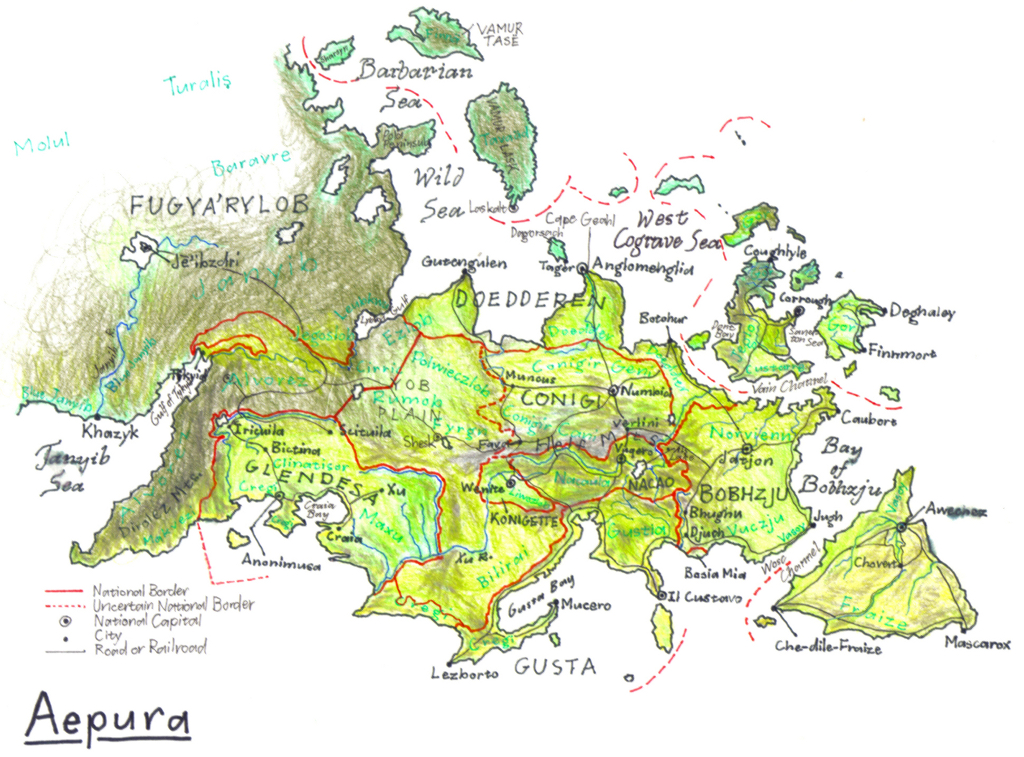
|
DID YOU KNOW...?
...Damátir Ando means "Dark Lord" in my first major conlang, Çomyopregi. |
Çomyopregi is nearly twelve years old now, and has changed considerably in that time. Weirdly enough, it actually began as a revision of Esperanto. Pretty soon I got the idea that since the Germanic, Romance, and Slavic languages - all the important languages of Europe - were Indo-European, Indo-European roots represented an important commonality that could be used for coining words for my language. I liked that idea better than picking a word randomly from either a Germanic, Romance, or Slavic language, so I sketched the sound-changes I wanted to occur and redid the vocabulary using reconstructed roots whenever possible. Soon I expanded the case system beyond my original nominative, accusative, and prepositional-case system. Then I added personal endings to verbs. I made a huge step finally by doing away with the principle of one ending per part of speech and dividing the nouns into three (still perfectly regular) declensions. By that time I wanted to make a language that could be suited for international but was more natural-seeming as well as, and every natural language had at least a couple different endings for each part of speech. I could have nouns with final vowels -a, -e, and -u and still have regular, logical plural and case forms. That didn't last long. I still had a system with case affixes that were separate from, and added on after, the plural formation, but then I developed a declension system with fused endings combining the concepts of number and case. At that point I realized my language was becoming too complicated and varied in its forms to serve well as an auxlang. What was I to do? Ah hell, I thought, and starting making irregular verbs. Since then, I have abandoned any intent of creating an auxlang and have just been designing it to be personally pleasing. (And I really don't like auxlangs anymore anyhow...too...dead.) There are still some ways in which it seems a bit too perfect for a real language, but it's greatly improved. My tongue now is so different in structure and style from Esperanto that had I not explained all this, you probably never would have guessed what it started out as.
The oldest part of Sopih is Glindesa and its language, Arajan, which also happen to be the oldest of the things that I am still working on in any capacity. Back in about 1997, when I was 11, there was some sort of fad of drawing funny maps of cool made-up places among the fifth-graders. Given my strong proclivity to drawing at that age, I participated in this a lot. I drew a big map of a city across several taped-together sheets of Xerox paper. Since I couldn't think of a proper name for it, I didn't really give it one, and it became "Anonymousville." The next year, one of my classmates got into self-glorification and "commissioned" me to write an epic legend about himself. Drawing on my child's knowledge of medieval and mythical stories, I did so, and the grandiose stuff we made up about him evolved into the story of King Marja I of Glindesa. Other characters in these romances were based on other people we knew. He eventually got tired of his own stories so I continued developing them myself. Marja needed someplace to rule from, so I drafted Anonymousville as his capital. Also, as I was beginning to become impressed by the wonder of language, and had read The Hobbit, I decided that a fantasy kingdom needed a fantasy language with weird names. I made up some Arajan words. To this date, many of the words of the Obic languages are deformed names of people I knew in grade school. Other words are pretty transparent corruptions of English words: "sorcerer" became zorza, the name for the Glindesan brahmanic caste. I invented an alphabet too, but there wasn't much in the way of grammar. Yet.
For awhile I tried to pretend that Glindesa was an actual historical kingdom, and I wrote about how a whole civilization had been recently discovered, somewhere in the area of the modern Ukraine. Later I gave up on this and it was moved to a new, empty world of its own. That world would slowly get populated by other peoples. The oldest papers I have of Sopih, some comparative lists of basic vocab in Obic and Aipuric languages, dates from mid-middle school (1999 or 2000).
As for the rest of the story...that will have to wait...

 Reguándóy domum
Reguándóy domum